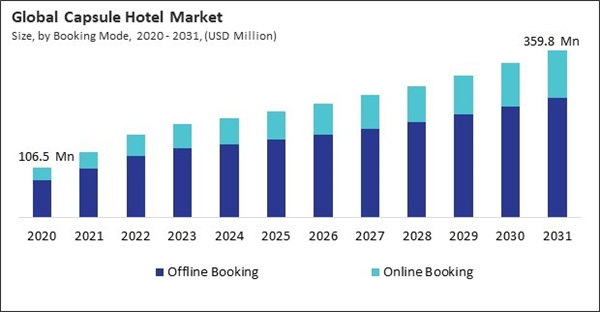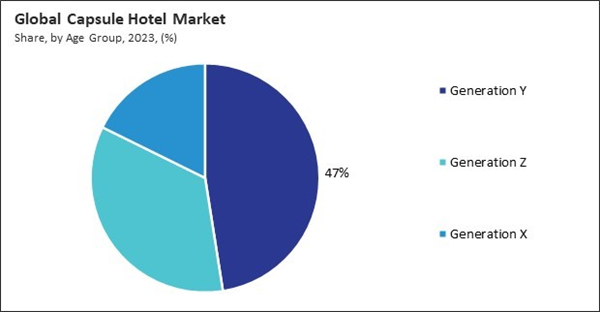The Global Capsule Hotel Market size is expected to reach $359.8 million by 2031, rising at a market growth of 7.7% CAGR during the forecast period.
Asia-Pacific cities are experiencing rapid urbanization, increasing population density, and a high demand for affordable, compact accommodations. Thus, the Asia-Pacific region acquired 52.4% revenue share in the market 2023. Capsule hotels optimize limited urban space by offering compact, functional rooms that cater to the needs of urban dwellers and travelers seeking convenient lodging options. Asia-Pacific countries attract many budget travelers, including backpackers and solo adventurers, who prefer affordable accommodations without compromising location or comfort.
Capsule hotels provide budget-friendly lodging options compared to traditional hotels. They typically offer lower nightly rates, making them attractive to budget-conscious travelers, especially in expensive urban areas with high hotel prices.
Additionally, urbanization leads to the expansion of cities and metropolitan areas, often resulting in a scarcity of available land for traditional hotels or large-scale developments. Capsule hotels offer a compact and space-efficient alternative that maximizes the use of limited urban space.
However, capsules in these are designed to be compact, typically measuring around 1 to 2 meters in length and width. This limited space confines guests to a small sleeping area with minimal room for movement or personal belongings. Thus, space and comfort limitations are hindering the growth of the market.
Asia-Pacific cities are experiencing rapid urbanization, increasing population density, and a high demand for affordable, compact accommodations. Thus, the Asia-Pacific region acquired 52.4% revenue share in the market 2023. Capsule hotels optimize limited urban space by offering compact, functional rooms that cater to the needs of urban dwellers and travelers seeking convenient lodging options. Asia-Pacific countries attract many budget travelers, including backpackers and solo adventurers, who prefer affordable accommodations without compromising location or comfort.
Capsule hotels provide budget-friendly lodging options compared to traditional hotels. They typically offer lower nightly rates, making them attractive to budget-conscious travelers, especially in expensive urban areas with high hotel prices.
Additionally, urbanization leads to the expansion of cities and metropolitan areas, often resulting in a scarcity of available land for traditional hotels or large-scale developments. Capsule hotels offer a compact and space-efficient alternative that maximizes the use of limited urban space.
However, capsules in these are designed to be compact, typically measuring around 1 to 2 meters in length and width. This limited space confines guests to a small sleeping area with minimal room for movement or personal belongings. Thus, space and comfort limitations are hindering the growth of the market.
Driving and Restraining Factors
Drivers- Cost-effectiveness of capsule hotels
- Increasing urbanization and population density
- Increasing tourism and travel industry worldwide
- Space and comfort limitations
- Target audience limitations of capsule hotels
- Airport and transit hub expansion
- Medical tourism support
- Lack of customization options
- Seasonal and operational challenges
Booking Mode Outlook
Based on booking mode, the market is divided into offline and online booking. In 2023, the offline booking segment garnered 73.6% revenue share in the market. Some guests prefer the convenience of booking a capsule room on-site, especially when they arrive at the hotel without a prior reservation.Age Group Outlook
On the basis of age group, the market is segmented into generation Y, generation Z, and generation X. In 2023, the generation Z segment attained 34.8% revenue share in the market. Capsule hotels often provide communal areas, co-working spaces, and social events that foster guest interaction.Traveler Type Outlook
By traveler type, the market is divided into solo and group. In 2023, the solo segment registered 82% revenue share in the market. Capsule hotels are often situated in prime urban locations or near transportation hubs, providing solo travelers with convenient access to city attractions, public transit, and dining options.Regional Outlook
Region-wise, the market is analyzed across North America, Europe, Asia Pacific, and LAMEA. In 2023, the North America region generated 23.2% revenue share in the market. Major cities in North America, such as New York City, San Francisco, and Toronto, experience high population density and urbanization trends.List of Key Companies Profiled
- The Bed KLCC
- PANGEA POD HOTEL
- Riccarton Capsule Hotel
- De Bedstee Capsules Hotel B.V.
- nine hours Inc.
- Book & Bed Tokyo (Atelier Book and Bed Co., Ltd.)
- NADESHIKO HOTEL
- The Capsule Hotel
Market Report Segmentation
By Booking Mode- Offline Booking
- Online Booking
- Generation Y
- Generation Z
- Generation X
- Solo
- Group
- North America
- US
- Canada
- Mexico
- Rest of North America
- Europe
- Germany
- UK
- France
- Russia
- Spain
- Netherlands
- Rest of Europe
- Asia Pacific
- China
- Japan
- India
- South Korea
- Singapore
- Australia
- Rest of Asia Pacific
- LAMEA
- Brazil
- Argentina
- UAE
- Saudi Arabia
- South Africa
- Nigeria
- Rest of LAMEA
Table of Contents
Chapter 1. Market Scope & Methodology
Chapter 2. Market at a Glance
Chapter 3. Market Overview
Chapter 4. Global Capsule Hotel Market by Booking Mode
Chapter 5. Global Capsule Hotel Market by Age Group
Chapter 6. Global Capsule Hotel Market by Traveler Type
Chapter 7. Global Capsule Hotel Market by Region
Chapter 8. Company Profiles
Companies Mentioned
- The Bed KLCC
- PANGEA POD HOTEL
- Riccarton Capsule Hotel
- De Bedstee Capsules Hotel B.V.
- nine hours Inc.
- Book & Bed Tokyo (Atelier Book and Bed Co., Ltd.)
- NADESHIKO HOTEL
- The Capsule Hotel
Methodology

LOADING...










